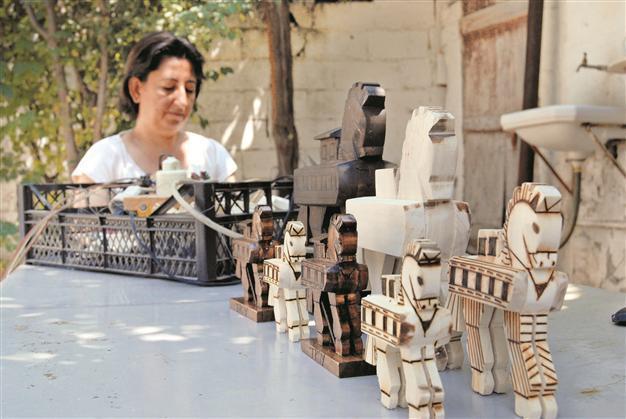Villagers earn living through Trojan horses, wait for the new regulations
ÇANAKKALE - Anadolu Agency

Villagers produce wooden Trojan horses in their own ateliers and sell them to tourists in the area in the entrance of the ancient city. AA photo
Villagers in the entrance of the ancient city of Troy in the northwestern province of Çanakkale, earn their living by selling models of the Trojan horse, which is a mythological symbol. The increase in the number of local and foreign tourists in the ancient city, which is located near Tevfikiye village, encouraged villagers to make and sell these models.
Some of the villagers, who are also dealing with agriculture and stockbreeding, produce wooden Trojan horses and war objects in their own ateliers and sell them to tourists in the area in the entrance of the ancient city.
The mukhtar of the village, Mehmet Er said that the number of those villagers was increasing every other day, adding, “Twenty families in our village are doing this job and we expected that this number will increase. The establishment of the Troy Museum, which is currently on the agenda, will be very advantageous for the village. Besides wooden horse patterns, we will also work on other object patterns. Our villagers sell their products in the area outside the ancient city. Tour travelers do not stop by this area and directly enter the ancient city. This is why villagers do not benefit from tourists visiting here. We have made attempts for the souvenir stands to be moved to the ancient city and for the establishment of a prayer room and post office.”
One of the villagers, Engin Cumalı said he had been producing souvenirs for 10 years with his wife in the atelier in his home. He said that they were producing bibelots in the shape of the Trojan horse and in seven different sizes, adding, “We give the shape of the wooden horse in the atelier. We make our living with this production but sales are stagnant. If tourist buses park in front of our stands, then we draw interest. This is why we produce for local groups and students.”
He also noted the difficulty of souvenir production, saying that a product was going through 25 different processions including drawing the raw material, cutting, burning, painting and etc.
Trojan HorseAccording to some historical sources, the Trojan horse is known as a tale from the Trojan War about the subterfuge that the Greeks used to enter the city of Troy and end the conflict.
After a 10-year siege, the Greeks constructed a huge wooden horse, and hid a force of men inside. They pretended to sail away, and the Trojans pulled the horse into their city as a victory trophy. That night the Greek force crept out of the horse and opened the gates for the rest of the Greek army, which had sailed back under cover of night. The Greeks entered and destroyed the city of Troy, decisively ending the war.
